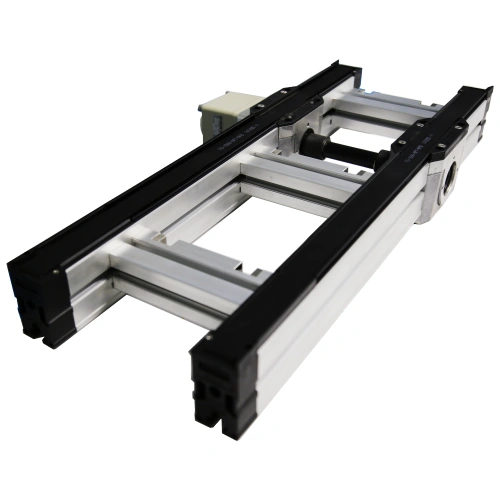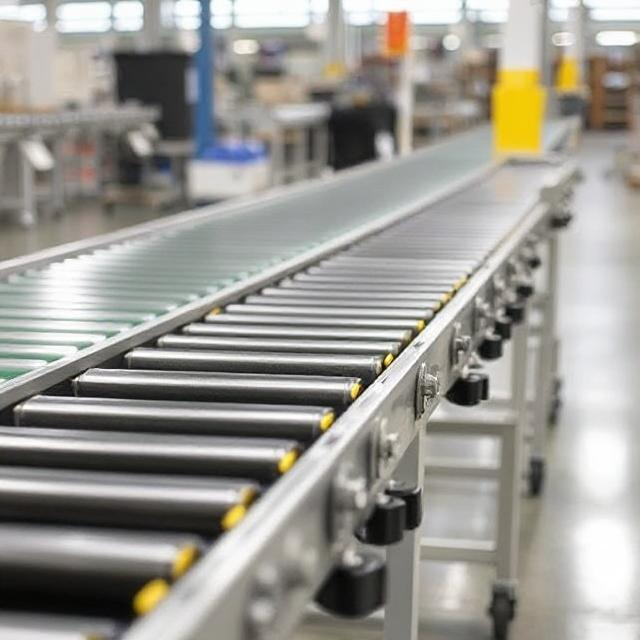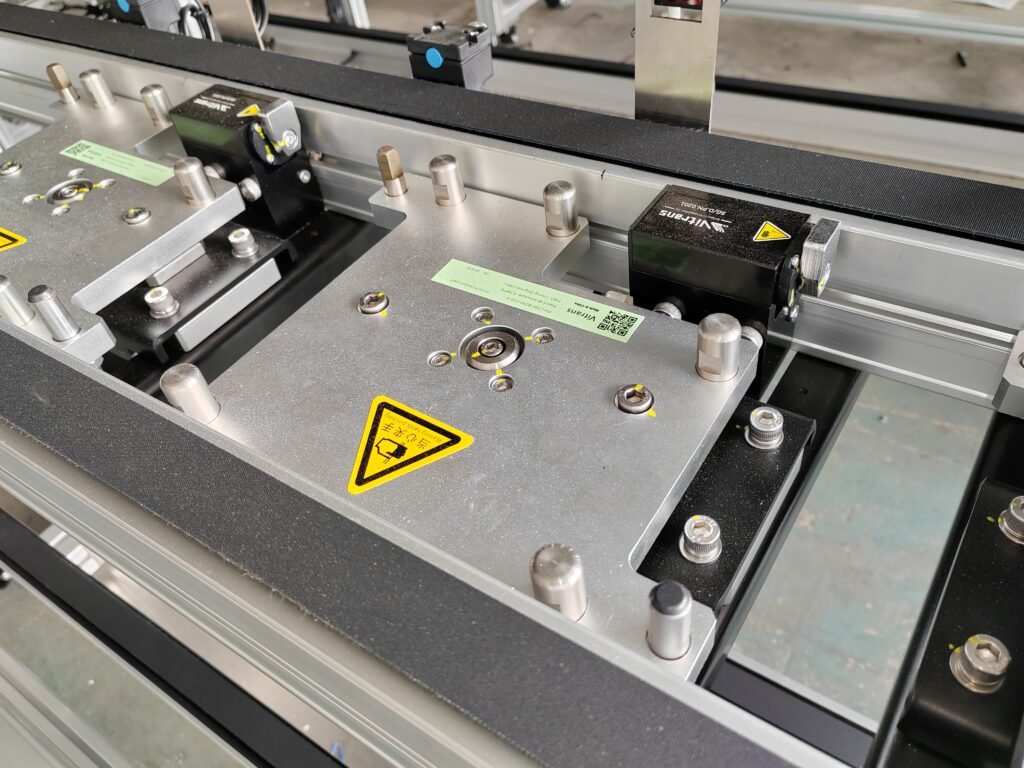Conveyor belts are one of the most vital components in the industrial sector, facilitating the transportation of goods across various stages of production, packaging, and distribution. These systems play a crucial role in streamlining processes, reducing labor costs, and enhancing productivity. With a diverse range of applications, conveyor belts come in different types and configurations, each designed to handle specific materials or tasks in the manufacturing process.
In this article, we will explore the types of conveyor belts commonly used in industry, the advantages of each, and the factors to consider when choosing the right belt system for your application. Whether you’re setting up a new production line or looking to optimize an existing one, understanding conveyor belt types is essential for improving efficiency and reducing downtime.
Types of Conveyor Belts Used in Industry
H2: 1. Flachbandförderer

Die flat belt conveyor is one of the most commonly used conveyor belt systems in the industrial sector. It features a continuous loop of material that moves over flat surfaces or rollers. These conveyors are often used for transporting products that need to be moved horizontally over a short distance or for items that need to be handled gently.
Features of Flat Belt Conveyors:
- Smooth surface: Ideal for moving small or delicate items.
- Flexibilität: Can be used in almost any industry, from food processing to automotive.
- Vielseitigkeit: Suitable for both inclined and horizontal transport.
Vorteile:
- Simple design and easy to maintain.
- High durability and ability to handle heavy loads.
- Flexible design allows for easy integration into existing systems.
Common Applications:
- Material handling in warehouses.
- Packaging and assembly lines.
- Retail stores for checkout counters.
Roller Bed Conveyor

A roller bed conveyor uses a series of rollers instead of a flat surface to carry products. The items are placed directly on the rollers, which rotate to move products along the belt. Roller bed conveyors are ideal for situations where heavy or bulky items need to be transported.
Features of Roller Bed Conveyors:
- Roller-supported design: Uses rollers to move items, reducing friction and wear.
- Low maintenance: Less prone to damage compared to other belt types.
- Heavy-duty handling: Can carry very heavy loads with ease.
Vorteile:
- Ideal for heavy or bulky materials.
- Requires less energy due to reduced friction.
- Durable and low-maintenance.
Common Applications:
- Heavy equipment or vehicle assembly lines.
- Logistics and distribution centers.
- Manufacturing of large parts or materials.
Modularer Gurtförderer

Die modular belt conveyor consists of individual interlocking plastic segments. This design allows for the belt to be easily customized and extended, making it suitable for complex conveyor systems. The modular design also enables easy repairs and adjustments, which is a key benefit in industries where continuous production is essential.
Features of Modular Belt Conveyors:
- Interlocking segments: Allow for easy repairs and customization.
- Smooth transitions: Ideal for transporting delicate or fragile products.
- Langlebigkeit: Resistant to chemicals, heat, and wear.
Vorteile:
- Easy to maintain and repair.
- Highly customizable to suit various applications.
- Suitable for industries dealing with food or medical products.
Common Applications:
- Food processing and packaging.
- Pharmaceutical manufacturing.
- Automotive and electronics industries.
Palettenförderer

Pallet conveyors are used to transport large, heavy items like pallets, containers, or crates. These conveyor systems are built to handle substantial weight and provide stability, often used in manufacturing, logistics, and warehousing applications. The pallet conveyor system is typically powered, with rollers or chains to transport items smoothly.
Features of Pallet Conveyors:
- Heavy-duty design: Built to handle large, heavy products.
- Adjustable speeds: To accommodate different operational requirements.
- Versatile: Can be used for both horizontal and vertical transport.
Vorteile:
- Reliable and durable for heavy-duty applications.
- Easy to install and configure.
- Supports both powered and non-powered systems.
Common Applications:
- Manufacturing and assembly lines.
- Warehouses for storage and order fulfillment.
- Shipping and distribution.
Inclined Conveyor
An inclined conveyor is used to transport materials up or down an incline. It’s commonly used when the production line needs to carry items between different elevation levels or when materials need to be fed into machines or production areas that are at a higher or lower level.
Features of Inclined Conveyors:
- Inclined design: Ideal for moving materials up or down steep slopes.
- Belt support: Ensures materials stay in place while being moved vertically.
- Variety of belt materials: Can be equipped with cleats, raised edges, or sidewalls to prevent items from falling off.
Vorteile:
- Facilitates easy transport between different elevations.
- Available in multiple configurations to handle diverse materials.
- Suitable for use in industries with complex spatial requirements.
Common Applications:
- Elevating bulk materials in mining or construction.
- Sorting and packaging operations.
- Loading and unloading docks.
Staukettenförderer
An accumulated chain conveyor uses chains rather than belts to move materials. The chain conveyor system allows for the accumulation of products in a line, enabling efficient handling of items. It’s often used in industries where precise control of material movement is required, such as the automotive and packaging sectors.
Features of Accumulated Chain Conveyors:
- High-load capacity: Suitable for heavy and bulky items.
- Precise control: Allows for controlled movement and accumulation of products.
- Heavy-duty chain design: Durable and resistant to wear.
Vorteile:
- Suitable for heavy loads and harsh environments.
- Provides precise control over product movement.
- Ideal for applications requiring product accumulation and sorting.
Common Applications:
- Automotive assembly lines.
- Food and beverage packaging.
- Warehouse sorting systems.
Anbaugeräte-Förderer
An attachment conveyor is similar to a modular belt conveyor, but it includes additional attachments that help to lift, lower, or support products. These attachments can be used for carrying odd-shaped items, lifting materials onto higher levels, or moving products through certain machines.
Features of Attachment Conveyors:
- Integrated attachments: Can have hooks, slats, or other specialized tools attached to the belt.
- Flexibilität: Highly adaptable for different applications.
- Customizable design: Can be tailored for specific needs in different industries.
Vorteile:
- Useful for handling irregular or fragile items.
- Highly customizable for various processes.
- Reduces handling time and improves productivity.
Common Applications:
- Automotive manufacturing.
- Food and pharmaceutical industries.
- Material handling and assembly lines.
Choosing the Right Conveyor System for Your Needs
Selecting the correct conveyor system for your production line is crucial for ensuring efficiency, reducing downtime, and increasing output. When choosing the right system, consider the following factors:
H3: 1. Material Type
Different materials require different types of conveyors. For heavy, bulk materials, a pallet or chain conveyor may be ideal, while smaller, lighter materials may do better on flat or modular belt conveyors.
H3: 2. Load Capacity
Conveyor belts come with various weight capacities. Make sure to choose a system that can handle the weight of the items you need to transport without overloading the system.
H3: 3. Environmental Conditions
Consider the working environment. For outdoor applications, you may need weather-resistant belts, while environments with extreme temperatures may require heat-resistant systems.
FAQs zu Förderbändern
1. How do I maintain a conveyor belt system?
Regular cleaning, lubrication, and inspection of the system are essential to maintain the conveyor belt. Ensure proper alignment and tension of the belt, and replace worn-out parts promptly.
2. What is the lifespan of a conveyor belt?
The lifespan of a conveyor belt depends on its material, usage, and maintenance. On average, a conveyor belt can last anywhere from 3 to 10 years with proper care.
3. Can I use the same conveyor belt for different materials?
It’s possible to use the same conveyor belt for different materials if they are compatible with the belt type. However, for maximum efficiency, it’s recommended to choose a belt tailored to the material being transported.
Schlussfolgerung
Conveyor belts are integral to the functioning of industries across the world. By understanding the different types of conveyor belts—such as flat belt conveyors, Palettenförderer, modular belt conveyorsund attachment conveyors—you can make an informed decision on which system is best suited for your specific needs. Whether you are in manufacturing, packaging, logistics, or any other industry, choosing the right conveyor belt system can significantly impact your productivity and efficiency.
If you are looking for reliable and high-quality conveyor systems, Vitrans offers a wide range of solutions. With over 10 years of experience and a strong supply chain network, Vitrans bietet Palettenförderer, accumulated chain conveyors, and other advanced systems designed to meet the unique needs of your industry. Reach out today to learn more about how our conveyor systems can help streamline your operations.




